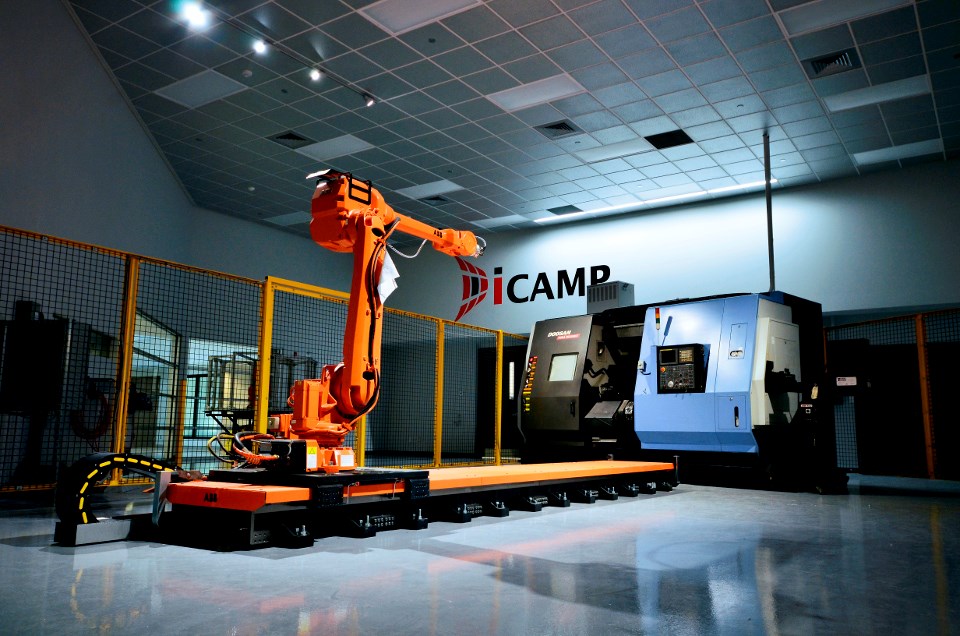North Bay’s Innovation Centre for Advanced Manufacturing and Production (ICAMP) is home to some of the most sophisticated technology available. And, yet, the state-of-the-art facility began its life as just a few scribbles on a napkin.
To follow the trail of evolution, we go back to September 2013. George Burton, president at Canadore College, and Brad Gavan, the college’s director of foundation, corporate, community and alumni partnership, were touring the community to speak with producers about what they needed to help grow their businesses.
Time and again they heard a similar message: companies wanted an opportunity to try out new equipment without having to financially commit to purchasing machinery they’d only use a handful of times a year. They also wanted access to prototyping technology to help them advance new ideas.
But that type of innovative facility was unavailable in the North.
“There was no place they could do prototyping with 3D printers, waterjet machines, design,” Gavan recalled.
“There was nothing to access for these companies to look at. And they also wanted to take back a lot of the stuff that might have been going overseas and control things.”
Similar facilities were proving successful around the world, and demand was strong at home. So, they thought, why not North Bay?
That’s when the initial concept got sketched out on the little napkin, and from there, the planning began.
Industry loved the plan – it offered the help they’d needed for years. Canadore College welcomed the idea of having a unique innovation centre on campus. And the public saw its potential in helping to grow the city.
Quickly, financial support for the $6.8-million build started to roll in from the federal and provincial governments, Canadore College, and industry partners.
The 8,500-square-foot centre opened for business in September 2013 with 3D printers, an electron microscope, a waterjet cutting table, and industrial robots. Just three years later, with demand growing, ICAMP expanded to 13,300 square feet and a whole host of new technology.
“It’s one of a kind,” Gavan said. “There’s no other concept like this in North America.”
Services today include product design, rapid prototype development, reverse engineering, 3D printing – in both metal and plastic – material and product testing, machining and cutting, process design and automation, and simulation.
ICAMP staff can provide training to companies and their employees so they can operate the equipment independently.
While a project is underway, labs can be locked so proprietary information can remain confidential, and intellectual property is always protected, Gavan stressed.
Companies can even seek assistance from faculty and students on certain projects, although it largely depends on the project being developed.
“ICAMP is for companies – industry first,” Gavan said. “Students and faculty get to participate, but it was about ICAMP and industry: how do we help industry innovate, prototype, test, go to market, and help the economy.”
ICAMP can even provide companies with assistance in accessing funds. The centre works closely with partners like Northern Ontario Heritage Fund Corp., FedNor, Innovation Initiatives Ontario North (IION), Ontario Centres of Excellence, the Natural Sciences and Engineering Research Council (NSERC), and the Industrial Research Assistance Program (IRAP).
“We want to make it easy for clients to say, hey, we can support you,” Gavan said.
Though ICAMP concentrates on the mining and manufacturing sectors, clients from across industries – forestry, aerospace, transportation, consuming goods, sporting goods, recreational vehicles, environmental products, and agriculture – have all accessed the centre’s services.
They’re open to any businesses that need them. Clients hail from North Bay, Sudbury, Sault Ste. Marie, Timmins and beyond.
“We’re for the North, just based in North Bay,” Gavan said.
To date, ICAMP has assisted 200 companies, participated in more than 560 projects, and helped retain or create 180 jobs.
ICAMP is currently working on plans for phase 3.0, which Gavan expects to get underway in spring 2020.
That will bring the total investment into ICAMP to $14.8 million.
Though plans are still in the works, Gavan sees demand for artificial intelligence (AI) and augmented reality capabilities.
Bringing augmented reality tools with them to tradeshows, for example, would allow a company to demonstrate for clients what a new generation truck might look like, rather than having to haul the actual truck with them.
Gavan expects this newest iteration of ICAMP to bring Northern Ontario companies to a whole new level of advancement. And that, he said, will help elevate the North and its reputation for quality products and services across the globe.
“Some of this technology are game-changers for the companies here,” he said.
“We’ll be able to work with clients to take their products to showcase so they can sell around the world, so they can come back, hire, produce, sell – stronger community. So we’re looking at that piece now, too.”
The Drift magazine features profiles on the people and companies making important contributions to the Northern Ontario mining service and supply sector. It is published annually and distributed at the Northern Ontario Mining Showcase during the Prospectors and Developers Association of Canada (PDAC) conference in Toronto.



